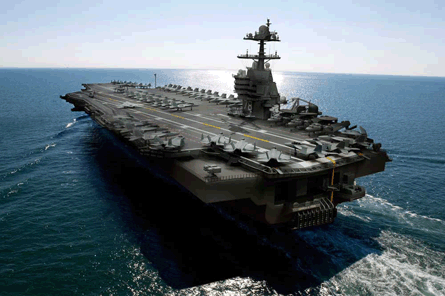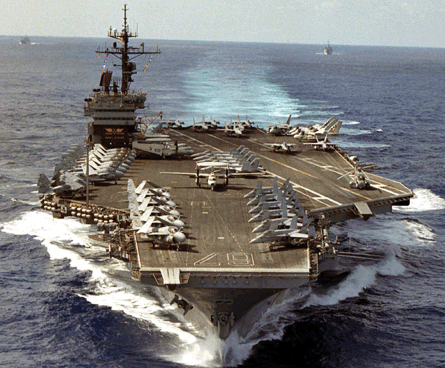 |
|---|
© Northrop GrummanHow Northrop Grumman sees the carrier deck of 2020 |
Retired Vice Adm Robert Dunn remembers being called to the Secretary of the Navy's office. It was 1989 and the US Navy was still at the peak of its Cold War, 600-ship glory. Defence spending, however, was already in decline and the navy's top civilian, Henry Garrett, had a tough decision to make. As deputy chief of naval operations for aviation, Dunn's portfolio included two projects for a carrier-based, long-range strike aircraft - a re-engined Grumman A-6E Intruder called the A-6F - and a far more ambitious project called the McDonnell Douglas/General Dynamics A-12 Avenger II.
"We can't afford the A-12 and the A-6F," Garrett told Dunn. "Which one do you want?" "I think we better go with the A-12 because that is going to be a more capable aircraft," Dunn said. Almost 22 years on, however, Dunn says: "In retrospect, I don't know if it was good advice or not." In fairness, there were few options. An era of naval aviation was coming to a close. In 1989, navy leaders could choose between two projects for a long-range strike aircraft; by the end of the next decade there were no such projects in development or anything similar in service.
On 7 January 1991, Secretary of Defense Richard Cheney cancelled the A-12, citing design shortfalls and cost overruns. Six years later, the navy retired the last A-6E with no true replacement. The navy was changing in 1989 and the future became about limiting schedule delays, cost overruns and high operating costs. At the time of Dunn's meeting with Garrett, however, it still seemed right to advocate for a revolutionary aircraft. "There was a time when the navy was pushing the envelope much more," says Eric Wertheim, author of the US Naval Institute's "Combat Fleets of the World". If there was any doubting the shift in strategy, in December 1992 the navy awarded Boeing a $3.72 billion contract to develop the F/A-18E/F Super Hornet, which meant abandoning the Grumman F-14 contract. "The basic problem with the F-14 - not that it wasn't a good aircraft, it was a superb aircraft - but the cost per hour of the F-14 was twice that of the F-18 and at that time, with the budgets coming down, it was a matter of affordability," Dunn says.
SUPER HORNET
"No question about it," says Norman Polmar, a naval consultant and author. "The F-14 in its time was one of the most versatile and capable fighter aircraft in the world. They proceeded with the Super Hornet at the direction of the Department of Defense in order to save maintenance money. I can assure you the F-14 was the preferred aircraft." Norman Friedman, another author and naval strategist, notes that the F-14 decision was in step with the navy's new operational vision, which implied a shift in emphasis from deep attack to littoral warfare.
"The key issue at the time was money - it often is," Friedman says. "There was also a conscious choice that the navy would not be doing heavy-duty deep strikes; those would be left to the air force, with Tomahawks doing the precision strikes. On that basis, the shorter-range F/A-18 was very attractive."
A major element in naval aviation identity to emerge after the early 1990s was a grudging reliance on other branches of the US military.
"Today the navy is content to depend on land-based tankers, whether they are air force or allied to do their work in Afghanistan or Iraq," Dunn says. "But we wanted to be self-contained in those days. [Aircraft] like the A-16, A-12 and F-14 were very attractive because they were long range. They didn't require as much refuelling as the [Vietnam-era Ling-Temco-Vought] A-7s and later the F-18s.
 |
|---|
© US NavyCarrier deck circa 1991 |
"More and more, with the kind of missions popping up around the world today, there's a dependency on land-based tankers. Somewhere along the way we have to work with our sister services. We can't be self-contained all the time." With the retirement of the last F-14D in 2006, the F/A-18A-D Hornet and the F/A-18E/F became the only tactical fighters on carrier decks fulfilling the key roles - air superiority and attack. The consolidation of the carrier deck was not limited to fighters. The retirement of the A-6 also meant the loss of the KA-6, the tanker variant that dramatically extended the range of carrier-based air attacks.
Some still think the navy's consolidation went too far, especially when the Lockheed S-3B Viking was retired and replaced by helicopters for anti-submarine warfare and maritime patrol missions. "NAVAIR and the navy have made a significant effort to reduce their logistics chains on carrier decks," Wertheim says, but retiring the Vikings "takes away a capability that you just don't replace. You can't argue that you aren't losing capability." Dunn, however, thinks the navy made the right decisions about consolidation. "I've been in favour of reducing the number of types of aircraft because it so simplifies the logistics and maintenance support, which in many ways are the long poles in the tent," Dunn says.
He also stresses that the S-3B's capabilities were not only replaced by helicopters. "Don't forget the satellites that we're depending upon," Dunn says. "As far as [anti-submarine warfare], they're depending more and more on [attack submarines] that are part of the battle group." It is a lesson that epitomises a slogan of modern management - do more with less. By contrast, the US Air Force took an entirely different approach in the early 1990s - it launched the F-22 programme.
A 2005 study by Rand's project air force analysed the results of these two approaches.
The Lockheed Martin F-22 introduced a fighter that combined stealth, supercruise and integrated avionics, including all-new airframe, structural materials, engine, radar and cockpit systems. The F/A-18E/F was based on an existing airframe, engine and avionics. While the F-22's development cost was $7.2 billion over budget, the F/A-18E/F was delivered on cost, the Rand report concludes.
"If you were to go back in time to 1990 and say this is how your acquisition strategy is going to end up in 2011, how are you going to feel about it? My feeling is the air force would really be rethinking it," Wertheim says.
"The navy invested in EA-18 Growlers instead of just putting all their investment in stealth," he adds. "The navy waited for that technology to mature somewhat. You're seeing some of the issues you're having with the F-22 with their reliability because of the maintenance requirement. Their reliability is not what they hoped for." Not everyone is convinced the navy's approach was the right one. Polmar says the F/A-18E/F strategy worked but it helps that the navy has not faced a more capable adversary. "So far we've not met any opponents that have been able to beat a formation of F-18s," he says.
LONG-RANGE BOMBER
That situation seems to be changing rapidly. In December, the US military acknowledged China had fielded an anti-ship ballistic missile. Both Russia and China have also revealed prototypes for fifth-generation fighters to compete with the F-22 and Lockheed Martin F-35. Meanwhile, US navy and air force strategies on next-generation combat aircraft seem to be going in opposite directions. The air force is developing a new long-range bomber, while the navy plans to introduce the F-35C on carrier decks by the end of the decade, along with a possibly revolutionary system called the unmanned carrier-launched airborne surveillance and strike (UCLASS) system. The navy may also replace the F/A-18E/F with the FA-XX in the mid-2020s. If the navy eventually combines the F-35C, UCLASS and FA-XX on to a single carrier deck, the capabilities of such a force would probably be recognisable to the fleet Dunn envisaged when he sealed the fate of the A-6F in Garrett's office in 1989.
"That's what it's all about," Dunn says. "Any thinking naval aviator will say the air force has the punch and the stay-ability if they have the bases. They don't often have the bases, so that's why the navy has to be ready."
Source: Flight International
















